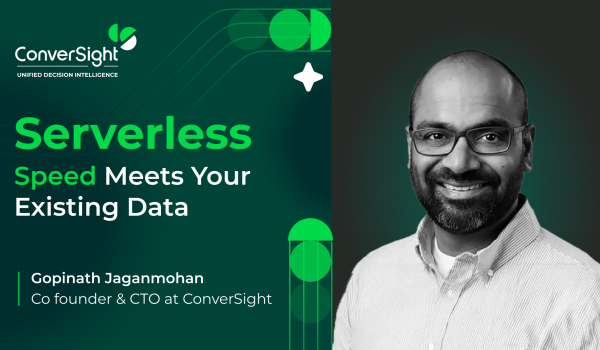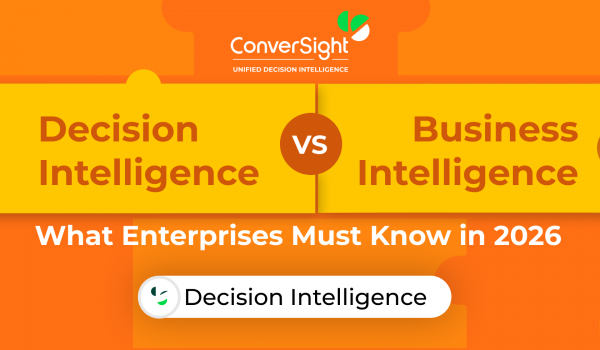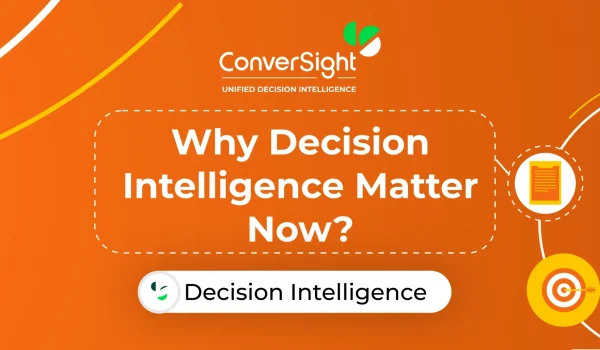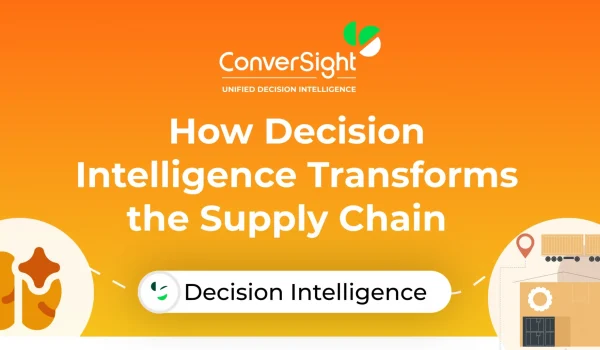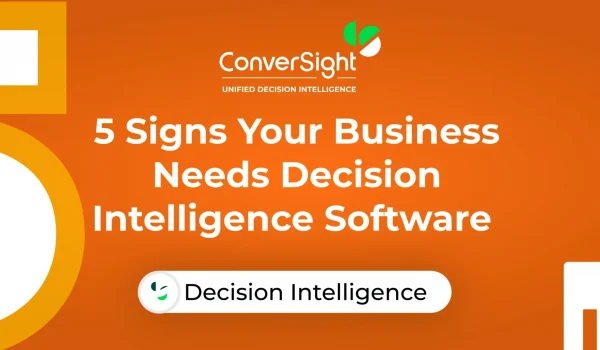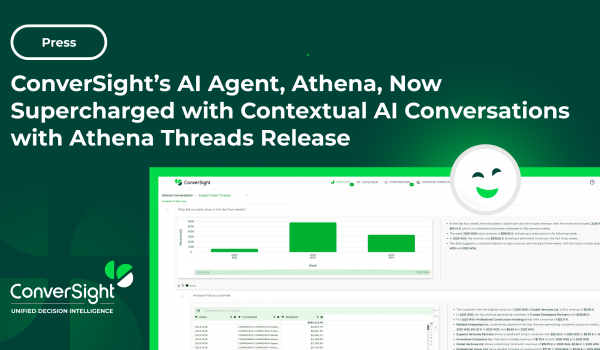Demand Forecasting in the Supply Chain: Why Choosing the Right Forecasting Software Matters
In today’s fast-paced, data-driven business environment, demand forecasting is more than just a supply chain function — it’s a strategic necessity. The right AI Demand forecasting software serves as the backbone for accurate planning, efficient resource allocation, and proactive decision-making. It can be the difference between maintaining lean inventory and facing costly overstocks or stockouts.
Inaccurate forecasts ripple across the organization. Excess inventory ties up capital and increases holding costs, while shortages lead to lost sales, dissatisfied customers, and potential damage to brand reputation. Poor visibility into future demand can also hinder production planning, delay procurement cycles, and strain vendor relationships.
Modern AI-powered forecasting tools bring automation, accuracy, and adaptability into the forecasting process. They not only account for historical trends but also incorporate real-time data and external variables like seasonality, promotions, and market shifts. This leads to better alignment between demand signals and business execution.
By investing in the right AI forecasting software, businesses can:
- Boost profitability through optimized inventory and reduced waste
- Improve customer satisfaction with better product availability and service levels
- Enhance operational efficiency by aligning production, logistics, and procurement
- Strengthen resilience against market volatility, supply disruptions, and demand shocks
- Enable faster, data-informed decisions across departments
Top Features Every AI Forecasting Tool Must Have
Not all AI demand forecasting tools are created equal. While many may offer predictive capabilities, only a select few combine the essential features that make forecasting truly reliable, scalable, and actionable across business functions.
When evaluating AI forecasting software, it’s critical to look beyond the buzzwords and assess what features will actually drive value for your team. The right tool should not only generate accurate forecasts but also support decision-making, collaboration, and real-world execution.
Here are the must-have features that define a high-performing AI forecasting solution:
- Multi-Model Forecasting Engine: The tool should support a range of forecasting models — including statistical (e.g., ARIMA), machine learning (e.g., XGBoost), and deep learning (e.g., LSTM). This ensures flexibility to choose the best-fitting model based on data behavior, product type, and planning horizon.
- Automated Model Selection & Tuning: Manually tuning models can be time-consuming and require advanced expertise. An ideal platform should automate model selection, hyperparameter tuning, and validation, allowing teams to get high-accuracy outputs with minimal manual effort.
- Real-Time Data Integration: The system must be capable of ingesting live or frequently updated data from ERP, CRM, POS, and external sources (e.g., weather, economic indicators). Timely data ensures forecasts reflect current market realities and not outdated trends.
- Scenario Planning & What-If Analysis: Advanced forecasting tools should allow users to simulate different demand scenarios — such as promotions, price changes, or supply constraints — and see the impact on forecasts. This supports proactive planning and more informed business strategies.
- Seamless ERP & System Integration: Forecasting doesn’t exist in a silo. The tool must integrate easily with existing business systems — ERPs, WMS, BI platforms — to streamline workflows and enable closed-loop planning.
- User-Friendly Interface & Self-Service Analytics: A powerful backend is only useful if it’s accessible to users. The tool should provide a clean, intuitive UI with visual dashboards, drag-and-drop functionality, and natural language querying — empowering business users, not just data scientists.
- Explainability & Transparency: Stakeholders need to understand why a forecast was made. Leading tools offer model explainability, insights into drivers, and confidence intervals — building trust in AI-driven outputs.
- Collaboration & Role-Based Access: Cross-functional collaboration is key in demand planning. The software should enable shared visibility, comments, and role-based access so that sales, operations, and finance teams can align on the same forecast.
- Scalable Architecture: As your data grows, the platform should scale with you — handling millions of records, multiple product hierarchies, and global locations without performance lag.
- Security & Compliance: Ensure the software meets enterprise-grade security standards (e.g., SOC 2, GDPR) and includes data encryption, access control, and audit logging to protect sensitive business information.
How Well Will It Work with Your ERP and Data Systems?
One of the most critical — yet often underestimated — factors in selecting AI demand forecasting software is integration capability. Even the most advanced forecasting models won’t deliver business value if they can’t connect to the systems where your data lives or where decisions are executed.
AI forecasting software must be able to ingest, interpret, and act on data from across your business ecosystem, particularly your Enterprise Resource Planning (ERP) system, which serves as the digital core of your supply chain, inventory, procurement, and sales operations.
Key Integration Capabilities to Look For
- Pre-Built ERP Connectors: Look for solutions that offer native integrations with major ERP platforms like SAP, Oracle, Microsoft Dynamics, NetSuite, Acumatica, or Infor. Pre-built connectors significantly reduce implementation time and complexity.
- Custom API Support: Open APIs and webhook compatibility are essential for connecting with homegrown or niche systems. RESTful APIs allow two-way communication and flexible data exchange.
- ETL and Data Pipeline Support: Built-in Extract, Transform, Load (ETL) capabilities or connectors to popular data pipeline tools like Snowflake, Azure Data Factory, or Fivetran ensure that large volumes of structured and unstructured data can be ingested and cleaned efficiently.
- Automated Data Refresh: The system should allow configurable data refresh schedules — daily, hourly, or real-time — based on business needs.
- Support for Cloud and On-Prem Systems: Many businesses operate hybrid environments. Choose a solution that can handle both cloud-based apps and on-premise data sources through secure tunnels or agents.
- Data Mapping and Transformation: The software should include tools or modules to align source data formats with the forecasting engine’s requirements — mapping product hierarchies, normalizing units, and handling missing values.
Understanding the Forecasting Models Behind the Software
Modern AI forecasting platforms use a variety of statistical, machine learning, and deep learning models to provide accurate and adaptive predictions. Each model is best suited for specific types of demand patterns, data availability, and business use cases. Below is a breakdown of core forecasting models used in AI tools — including when to use them, strengths, and potential limitations.
Auto-ARIMA
Overview: Auto-ARIMA (Auto-Regressive Integrated Moving Average) automates the selection of optimal parameters for traditional time series forecasting. It’s well-suited for consistent, short-term forecasting where historical trends and seasonality are stable.
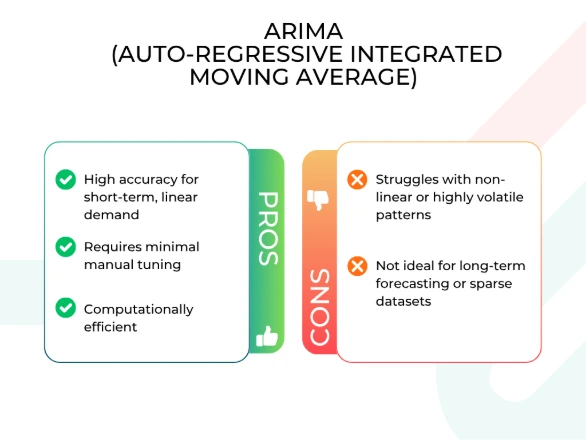
Prophet
Overview: Developed by Meta (Facebook), Prophet is designed to model time series data with strong seasonality and recurring events. It automatically detects holiday effects, seasonal shifts, and trend changepoints — making it ideal for businesses with cyclical demand.
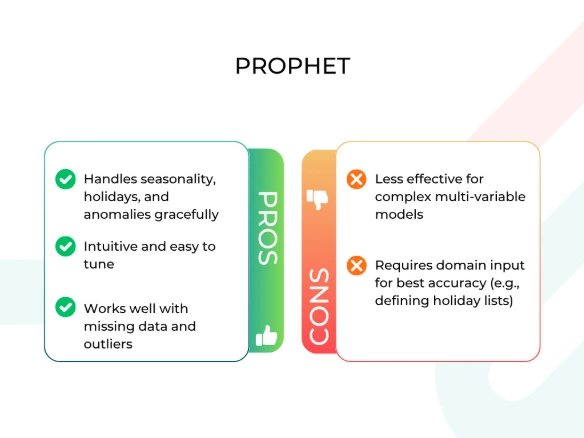
LSTM (Long Short-Term Memory Networks)
Overview: LSTM is a type of recurrent neural network (RNN) capable of learning long-term dependencies in sequential data. It is well-suited for complex, nonlinear time series where traditional models fail to capture irregular fluctuations.
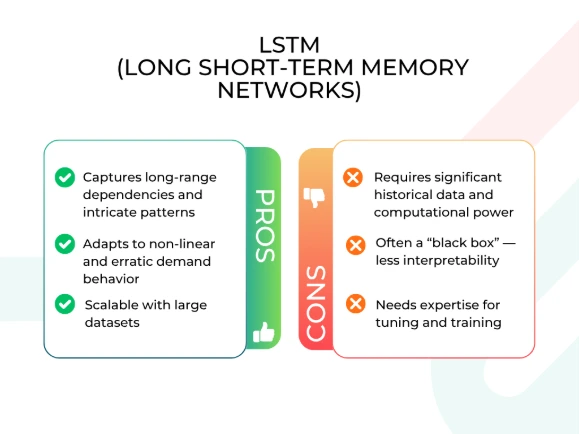
Machine Learning and Ensemble Methods
Overview: These approaches use supervised learning algorithms — such as Random Forest, Gradient Boosting (like XGBoost), and ensemble models — to incorporate multiple variables (e.g., price changes, promotions, external market signals) for robust demand forecasting.
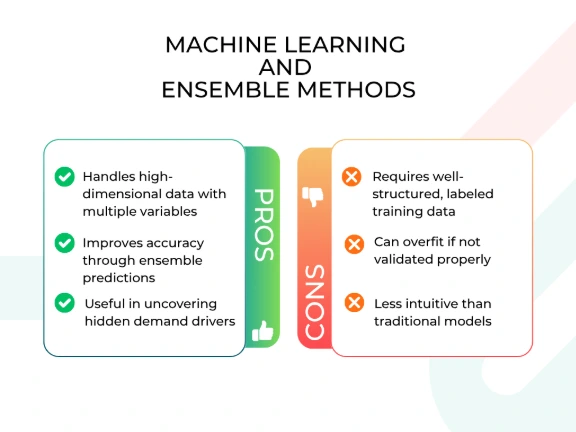
Finding the Right Fit: Industry-Specific Forecasting Needs
AI demand forecasting software is not a one-size-fits-all solution. Each industry comes with its own complexities, patterns, and priorities — from handling promotions in retail to optimizing raw material flow in manufacturing. Choosing software that understands your industry’s nuances is essential to achieving reliable forecasts and operational efficiency.
Retail: Fast-Moving, Promotion-Sensitive Demand
Overview: In retail, forecasting must adapt to rapidly changing consumer preferences, localized events, promotional spikes, and seasonal trends. With fluctuating foot traffic, flash sales, and diverse product lines, precision and agility are key.
AI demand forecasting software for retail must deliver high-frequency updates and adapt quickly to promotional events.
Key Priorities:
- High-frequency, short-term forecasting (daily/weekly)
- Promotion and markdown planning integration
- Regionalized and store-level demand prediction
- Inventory optimization across channels (online, in-store)
AI Capabilities to Look For:
- Real-time data ingestion and forecasting updates
- Promotion-aware models (e.g., uplift modeling)
- Integration with POS and marketing data sources
- Visual dashboards for merchandise planning
Manufacturing: Long Lead Times & Resource Planning
Overview: Manufacturers deal with long planning cycles and dependencies on raw materials, labor, and production schedules. In this sector, AI demand forecasting software plays a vital role in aligning demand with production and resource availability.
Key Priorities:
- Long-term and medium-term forecasting for MRP (Material Requirements Planning)
- Capacity and labor planning
- BOM (Bill of Materials) alignment
- Supplier lead time variability
AI Capabilities to Look For:
- Multi-tier BOM and component-level forecasting
- Scenario planning for make-to-stock vs make-to-order models
- Integration with ERP/MES systems
- Downtime and maintenance impact modelling
Distribution: Network-Wide Inventory Visibility
Overview: Distributors manage complex networks of warehouses, vendors, and delivery schedules. The right AI demand forecasting software for distribution helps aggregate demand across locations while avoiding overstock and ensuring product availability.
Key Priorities:
- Multi-location, multi-tier inventory forecasting
- Lead time variability across zones
- Demand pooling and aggregation
- Forecasting by customer, region, or SKU group
AI Capabilities to Look For:
- Hierarchical forecasting models (SKU → Category → Region)
- Dynamic safety stock optimization
- Route and logistics-aware planning
- Real-time exception alerts (stockouts, backorders)
User-Friendly by Design
AI demand forecasting software shouldn’t just be powerful—it must also be approachable. Usability is critical to adoption, especially when business analysts, planners, and inventory managers—not just data scientists—are the end users.
Modern platforms should prioritize intuitive interfaces, no-code or low-code environments, and guided experiences. This allows teams to access, adjust, and interpret forecasts without relying on IT or data teams. Features like drag-and-drop dashboards, natural language queries, and interactive visualizations help translate complex data into clear, actionable insights.
Key usability factors to look for:
- Self-service dashboards and reporting
- Natural language or conversational interfaces
- Role-based views for executives, planners, and analysts
- Embedded tooltips, walkthroughs, and onboarding tutorials
Data Security and Forecast Accuracy
When it comes to AI and business-critical forecasts, trust is everything. Companies must ensure that the platform not only delivers accurate predictions but also protects sensitive data.
AI models are only as good as the data fed into them. A secure system must support encrypted data pipelines, secure cloud infrastructure, and compliance with regulations like GDPR, HIPAA, or SOC 2. Just as important is the model’s resilience—ensuring accuracy even when data inputs change or become incomplete.
What to prioritize:
- End-to-end encryption (data at rest and in transit)
- Secure access control and user permissions
- Audit trails and model explainability
- Accuracy benchmarks and error analysis tools
Evaluating the Cost and ROI of AI Forecasting Software
The price of forecasting software isn’t just about licensing—it’s about total cost of ownership (TCO) and the value it brings over time. While some tools charge per user or per feature, others scale with data volume or integrations.
To evaluate ROI, consider what the software enables: fewer stockouts, reduced carrying costs, less time spent on manual reporting, and more informed decisions. Look for vendors that offer transparent pricing and highlight measurable gains.
Key cost factors to assess:
- Licensing and subscription models
- Onboarding and training costs
- Integration and customization efforts
- Ongoing support and scalability
Don’t Just Pick Software—Choose the Right Partner
A great platform means little without the right people behind it. Support, training, and a strategic relationship can significantly influence your success.
Vendors should act as partners—offering hands-on onboarding, industry insights, and dedicated account support. It’s also important to assess the product roadmap: Is the vendor innovating? Do they seek user feedback? Can they grow with your business?
Evaluate the vendor on:
- Implementation support and turnaround time
- Access to customer success and technical teams
- Availability of documentation, training, and webinars
- Proven experience in your industry
ConverSight: Your AI Forecasting Partner
ConverSight delivers more than just software—it delivers guided intelligence that transforms how businesses plan, predict, and perform. Built as an AI-powered decision intelligence platform, ConverSight empowers users with pre-configured forecasting models, smart automation, and a conversational interface that makes complex data easily accessible and actionable.
Whether you’re a supply chain manager, financial analyst, or sales planner, ConverSight is built to help you harness the full power of your data—without needing a background in data science. It integrates effortlessly with your existing ERP, CRM, and BI systems, unifying information across departments to create a single source of truth for accurate, real-time forecasting.
At the heart of ConverSight is Athena, its AI-powered conversational assistant. Athena enables users to query data in natural language—making it easy to ask questions like “What’s my projected demand for Q3?” or “Which SKUs are at risk of stockout next month?” This turns forecasting into a collaborative, intuitive, and dynamic process, where insights are generated at the speed of conversation.
From demand sensing and trend detection to inventory optimization and scenario planning, ConverSight’s AI demand forecasting software is purpose-built to deliver measurable outcomes—reducing costs, increasing service levels, and improving decision speed.
Why ConverSight Stands Out:
- Pre-built forecasting templates with industry-specific logic for retail, manufacturing, and distribution
- AI-driven recommendations that go beyond static reports, enabling users to act on forecast insights instantly
- Scalable architecture that integrates with ERP, CRM, data lakes, and third-party systems for unified data visibility
- Conversational AI (Athena) for self-service forecasting through plain language queries
- Real-time forecasting updates based on the latest demand signals, supplier data, and inventory movement
Whether you’re looking to reduce excess inventory, respond faster to market changes, or improve your forecast accuracy by 20–30%, ConverSight equips your teams with the tools and intelligence to shift from reactive to proactive planning—faster, smarter, and with less technical overhead.
Final Checklist: How to Make a Confident Decision
To wrap up your search for the right AI demand forecasting software, here’s a final checklist to guide your evaluation. Use it to assess vendor demos, compare options, and ensure your chosen platform meets both short- and long-term needs.
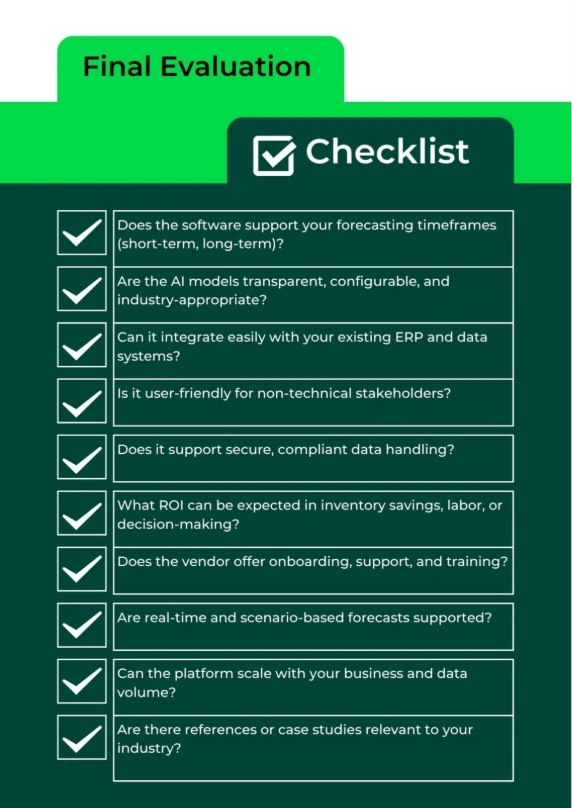
With the right partner and the right platform, demand forecasting becomes a strategic advantage—driving accuracy, agility, and alignment across the organization.
Ready to Upgrade Your Forecasting?
AI-powered demand forecasting software is no longer optional—it’s your competitive edge. Discover how the right platform can increase forecast accuracy, reduce costs, and improve planning across your organization. Read the AI Demand Forecasting whitepaper to learn more.


